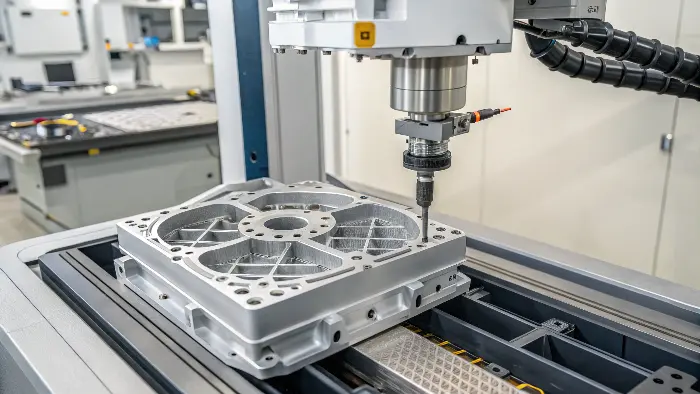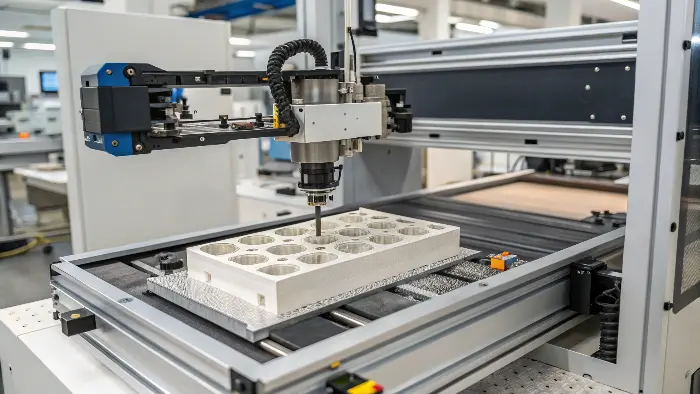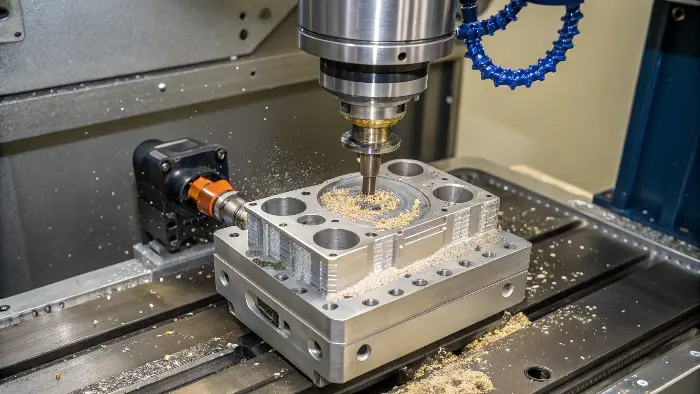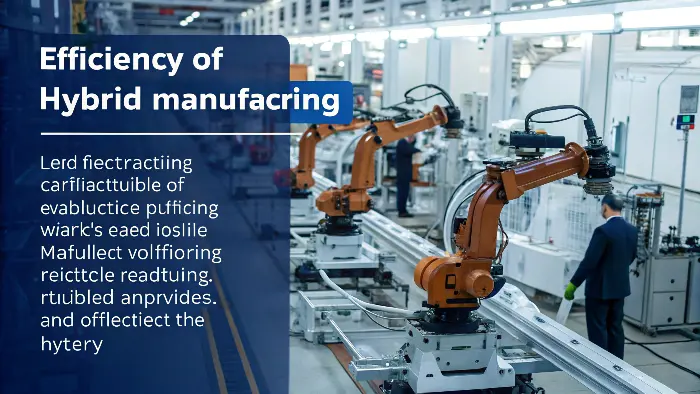Designing complex parts with internal channels or intricate geometries is a constant struggle. Traditional methods are often too limited or expensive, forcing you to compromise your design. Hybrid manufacturing offers a single-machine solution, combining the best of both worlds to create parts once thought impossible.
Hybrid manufacturing solves complex part challenges by integrating additive processes (like 3D printing) and subtractive processes (like CNC machining) into a single workflow. This allows for the creation of intricate internal features with the precision and surface finish of traditional machining, all in one setup, reducing lead times and improving part quality.

This technology might sound like something from the future, but it’s solving real-world engineering problems today. I’ve seen how it can completely change the way we think about what’s possible in part design and production. It’s not just about making the same parts a different way; it’s about making entirely new parts that couldn’t exist before. Let’s dive into what this process is, how it works, and what it can do for your projects.
What Exactly is Hybrid Additive and Subtractive Manufacturing?
You hear terms like "hybrid manufacturing" but might not be sure what they mean for your projects. It can sound complex and expensive, maybe not relevant to your day-to-day work. But understanding this technology can unlock new design possibilities and dramatically simplify your production chain.
Hybrid additive and subtractive manufacturing is a process where a single machine combines both 3D printing (additive) and CNC machining (subtractive) technologies. It builds up material layer by layer and then uses cutting tools to machine it to precise dimensions and a fine surface finish, often within the same build cycle.

At its core, hybrid manufacturing merges two fundamentally different approaches into one seamless operation. I like to think of it as giving a sculptor two sets of tools. First, they use an additive process to add big chunks of clay, quickly building up the basic form of a statue. Then, they switch to a subtractive process, using fine carving tools to remove small bits of clay, creating the intricate details, sharp edges, and smooth surfaces.
A hybrid machine does exactly this, but with metal or plastic. It has a tool head that can deposit material, and another tool head (or a tool changer) that holds end mills, drills, and other cutting tools. This combination allows it to perform tasks that are impossible for either process alone. For example, it can print a hollow structure with internal support lattices and then machine the critical mating surfaces on the outside, all without ever removing the part from the machine. This integration is the key to its power.
Here’s a simple breakdown of the two processes it combines:
| Process Type | Core Function | Common Technologies | Best For |
|---|---|---|---|
| Additive | Adds material layer-by-layer | Directed Energy Deposition (DED), Powder Bed Fusion (PBF) | Creating complex internal geometries, near-net shapes, adding features |
| Subtractive | Removes material from a solid block | CNC Milling, Turning, Grinding | Achieving tight tolerances, fine surface finishes, creating precise holes and threads |
By putting both capabilities into one machine, you eliminate the need for multiple setups, complex fixtures, and the risk of errors that come from moving a part between different machines.
How Do Hybrid Machines Build and Refine Complex Parts?
Creating parts with deep, curved internal cooling channels or lightweight lattice structures is a nightmare with traditional CNC alone. You either can’t make the part at all or have to weld multiple pieces together, which introduces weak points and potential for failure. Hybrid machines solve this by building and finishing these features in a single, seamless process.
Hybrid machines build complex parts using additive techniques like Directed Energy Deposition (DED) or Powder Bed Fusion (PBF) to create near-net shapes, including internal features. Then, integrated CNC milling or turning tools machine critical surfaces, threads, and holes to achieve tight tolerances and superior finishes before the part is fully enclosed.

The real magic of hybrid manufacturing happens in the build-and-machine cycle. It’s not just a matter of 3D printing a part and then cleaning it up with a CNC mill. The process is far more integrated.
The Build-and-Machine Workflow
Imagine you need to create a component with a complex, curved internal channel that needs a very smooth surface for fluid to flow efficiently. Here’s how a hybrid machine would tackle it:
- Add Material: The additive head (using a process like DED) deposits a few layers of metal powder, building the base of the part and the bottom of the channel.
- Machine Internals: Before the channel is enclosed, the machine automatically switches to a small milling tool. It enters the partially built channel and machines the surface to the required smoothness and dimensional accuracy.
- Add More Material: The machine switches back to the additive head and deposits more layers, building the walls and eventually the roof of the channel, enclosing the perfectly finished internal surface.
- Repeat: This cycle of adding and machining continues until the entire part, with its complex internal geometry, is complete.
- Final Machining: Finally, the CNC tools perform a finishing pass on all external surfaces, holes, and mounting points to ensure the entire component meets spec.
This approach allows us to create features that would otherwise be completely inaccessible to a cutting tool. I remember a project for a client in the aerospace industry who needed a manifold with intersecting, curved passageways. We couldn’t have made it as a single piece any other way.
Key Additive Technologies Used
| Technology | How It Works | Best Suited For |
|---|---|---|
| Directed Energy Deposition (DED) | A nozzle blows metal powder into a melt pool created by a focused laser or electron beam. | Adding features to existing parts, repairs, creating large components. It’s like a very precise welder. |
| Powder Bed Fusion (PBF) | A laser or electron beam selectively melts thin layers of fine metal powder in a build chamber. | Creating highly complex and intricate geometries, like internal lattices and medical implants. |
PBF is often the best choice for creating those extremely complex internal structures because of its precision, while DED is fantastic for repairing high-value parts or adding custom features to a standard component.
What are the Real-World Advantages of Using Hybrid Manufacturing?
Juggling multiple suppliers, complex assembly steps, and long lead times for a single complex component is inefficient and costly. Each step adds potential for error, delays, and communication breakdowns, putting your project timeline and budget at risk. Hybrid manufacturing consolidates this entire process, offering significant, tangible benefits.
The real-world advantages of hybrid manufacturing include drastically reduced lead times by eliminating multiple machine setups, increased design freedom for complex geometries, and improved part integrity by creating monolithic components instead of assemblies. It also enables efficient material usage and the ability to repair high-value parts.

For an engineer like Alex, who is focused on precision and efficiency, the benefits of hybrid manufacturing are not just theoretical. They translate directly into better parts, delivered faster. I’ve seen these advantages firsthand with my clients.
1. Consolidated Production and Shorter Lead Times
The most immediate benefit is the simplification of the supply chain. Instead of designing a part, sending it out for casting or printing, getting it back, setting it up on a CNC machine for roughing, then another for finishing—you do it all in one place. This "done-in-one" approach slashes lead times. For a prototype, this can mean getting a functional part in days instead of weeks. It eliminates the time lost in shipping, queueing, and setting up the part on different machines.
2. Unprecedented Design Freedom
This is where things get exciting for designers. Hybrid manufacturing removes many of the constraints of traditional Design for Manufacturability (DFM). You can design parts based on optimal performance, not on what a milling tool can reach.
- Conformal Cooling Channels: In injection molds, you can create cooling channels that follow the exact contour of the part, leading to faster cycle times and higher quality plastic parts.
- Lightweight Structures: You can design parts with internal lattice structures, making them incredibly strong yet lightweight—perfect for robotics and aerospace.
- Part Consolidation: An assembly of 10 different machined and welded parts can be redesigned as a single, stronger, monolithic component.
3. Enhanced Part Performance and Integrity
When you create a part from a single block of material or build it monolithically, you eliminate the weak points that come from welds, bolts, or brazing. This results in a stronger, more reliable component. Furthermore, some hybrid machines can use different materials within the same part. For example, you could build the body of a part with durable stainless steel and then coat a specific surface with a hard, wear-resistant material, all in one process.
4. Sustainable and Cost-Effective Repairs
Think about a high-value component like a turbine blade or a large industrial gear that has become worn or damaged. Traditionally, you’d have to scrap it and buy a new one for a huge cost. With hybrid DED technology, you can scan the worn area, add new material exactly where it’s needed, and then machine it back to its original dimensions. This repair capability is a game-changer for heavy industry, saving companies millions in replacement costs and reducing waste.
Conclusion
Hybrid manufacturing is more than just a new trend; it’s a fundamental shift in how we can approach complex engineering challenges. By combining the creative freedom of additive processes with the precision of subtractive machining, it opens doors to creating stronger, lighter, and more efficient parts in less time.


